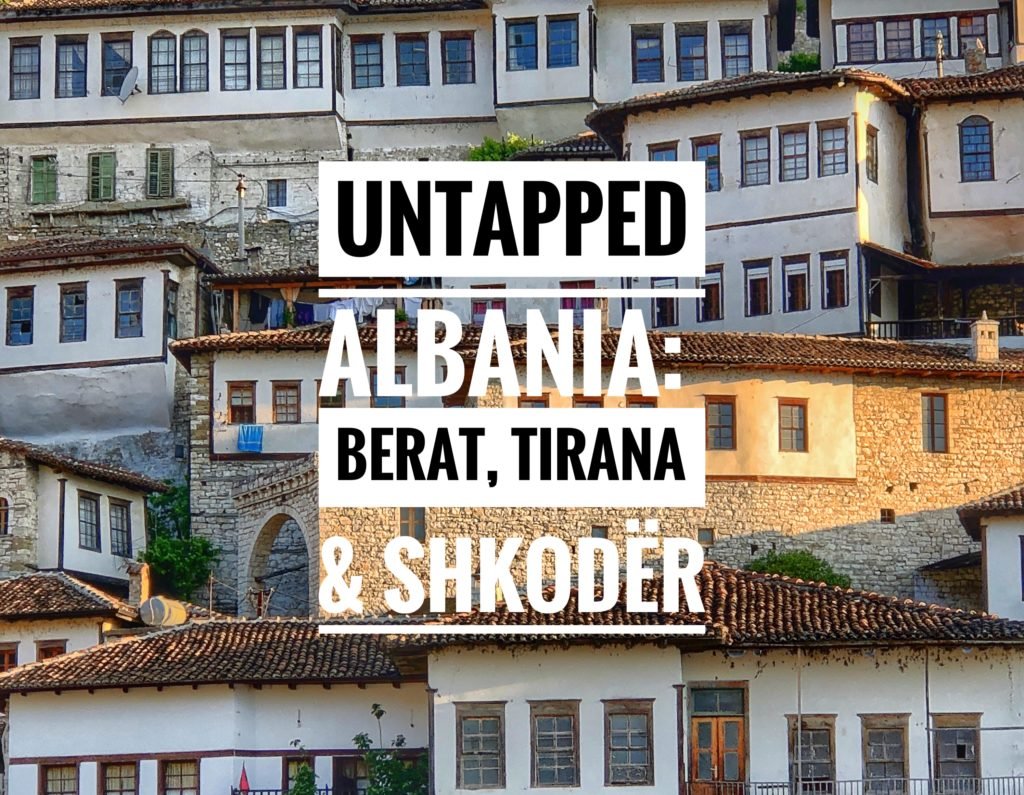
The Albanian state tourism slogan for 2019 is incredibly, “Be Taken by Albania.” It’s a peculiarly cheeky nod to the kidnapping-centered movie series “Taken.” A perplexing choice for a tourism slogan to be sure. But they went with it. And now, we have to agree, the slogan kind of… fits. On our final Albania post in this series, we do feel that we were taken by Albanina.
Taken by the mesmerizing UNESCO world heritage town of Berat, where its uniquely remarkable ottoman architecture paints a picture that seems custom made for a jigsaw puzzle makers’ ideal 1000 piece puzzle. Then, we move on to the grittier capital of Albania, Tirana (and what turned out to be a perfect stop for dental tourism!). Tirana may not feature high on most (or any) travelers want-to-see lists, but it is certainly worth a stopover and the longer we stayed, the more we started to be… yes… snatched up, by this arresting city. And lastly, the transitional city of Shkodër, where we found our sensibilities captured by its lovely pedestrianized streets, bustling cafes, and a distinct Montenegrin feel. All this wraps up one of the most surprising sleeper hits and makes Albania one of our favorite countries yet. And yes, for those who want to know, it’s on “our list…”

Berat, also known fittingly as the “town of 1000 windows” sits on a dramatic limestone massif that juts upward from a serenely flowing river that slices the town in two. The hillsides are jam packed with hundreds of seemingly identical white Ottoman-style houses with perfectly wide-eyed windows that intensely attempt to stare you down. Above the town is the massive and remarkably still inhabited fortress. As with many places in Albania, Christianity and Islam coincide peacefully together. This photo was taken from the Piccolo Grande Amore where we had lunch.
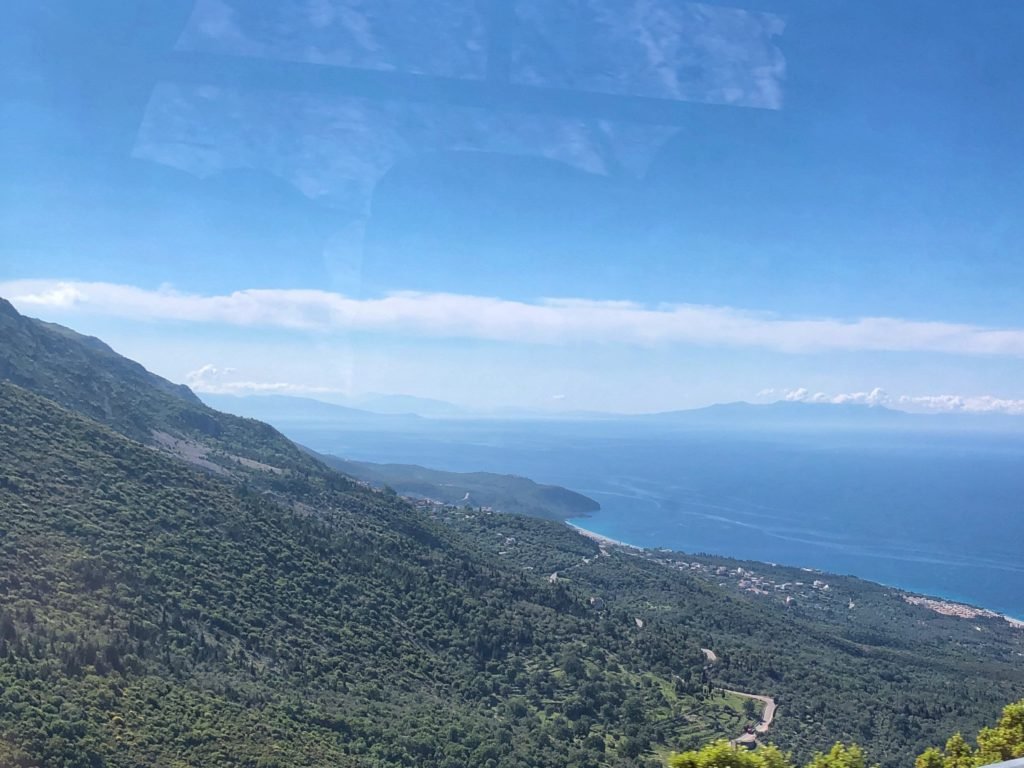
Getting to inland Berat from Himare on the coast, we took a mini bus to Vlore ($3.50/ticket) on a road that gave us another taste of just how ridiculously mountainous Albania is! Not long after hopping in from Himare our bus wound up the mountains like a serpent from sea level to 2000 meters and over the countless hairpin turns. Then, more serpentine maneuvers on the way down. Fortunately the roads were in excellent condition, and we had some very good and slooow drivers of our buses. A very quick transfer in the seaside town of Vlore, where we are efficiently herded from one mini bus to another (with German precision) to continue on to Berat. (800 Albanian Lek)

In Berat, we eagerly dumped our bags in our room, and sped off to this restaurant/pizzeria where we feasted on quality food and this view. Our meal included a traditional Albanian cold soup called Tarator, made with yogurt, cucumber, dill, salt and garlic. It was deliciously refreshing! We remembered having something similar in Ukraine. Soooo good!

The main pedestrian walkway in Berat is the size of a boulevard (width and length!), but it’s people only. What a wonderful concept! It was lined with a lovely park on one side and al fresco restaurants on the other.
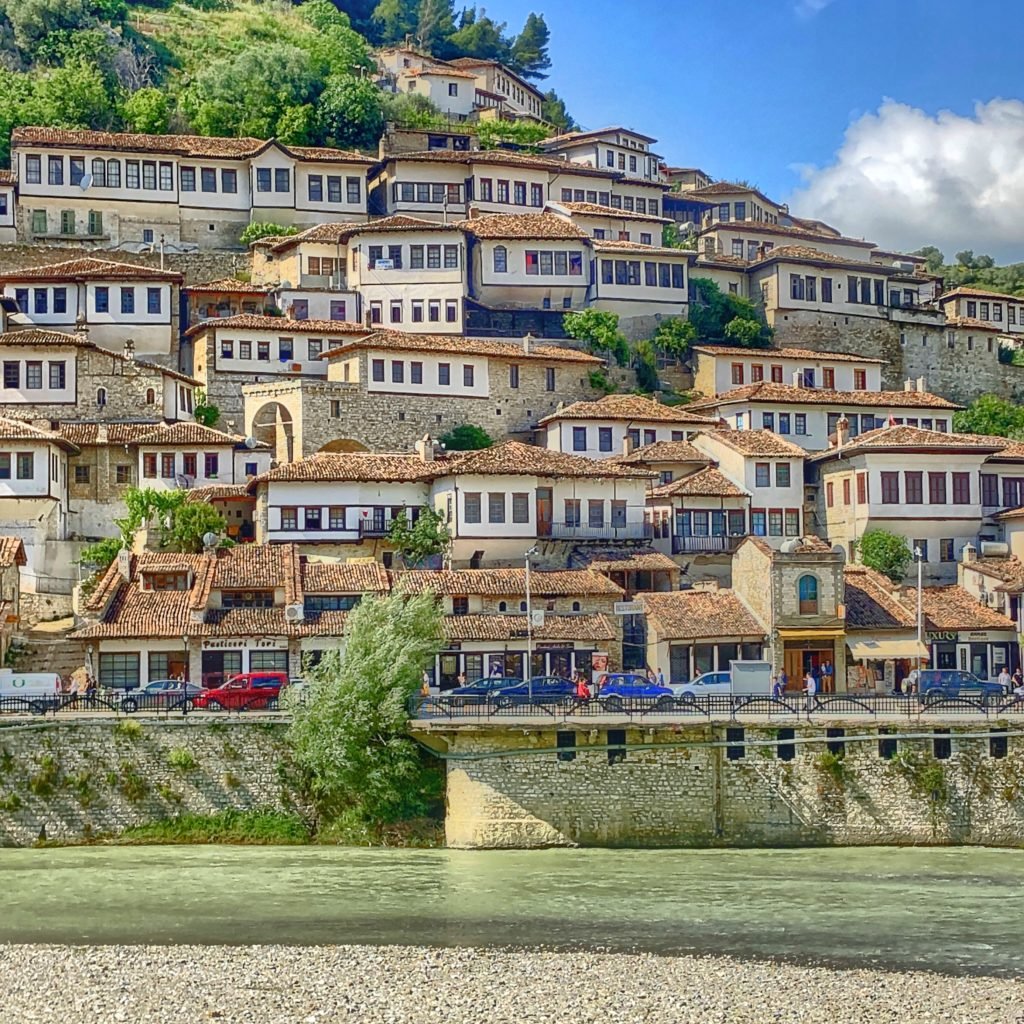
Berat, amazingly, has been inhabited since 600 BC. We are still floored (and delighted) that a town this freakin’ beautiful can have so very few tourists. We even stayed in a historic home in the center of Old Town for just $20/night.

The Byzantine style churches are gorgeous in Berat! Walking around they seem to pop up in the most random of places, like far up on this hillside. It doesn’t even seem accessible by road.
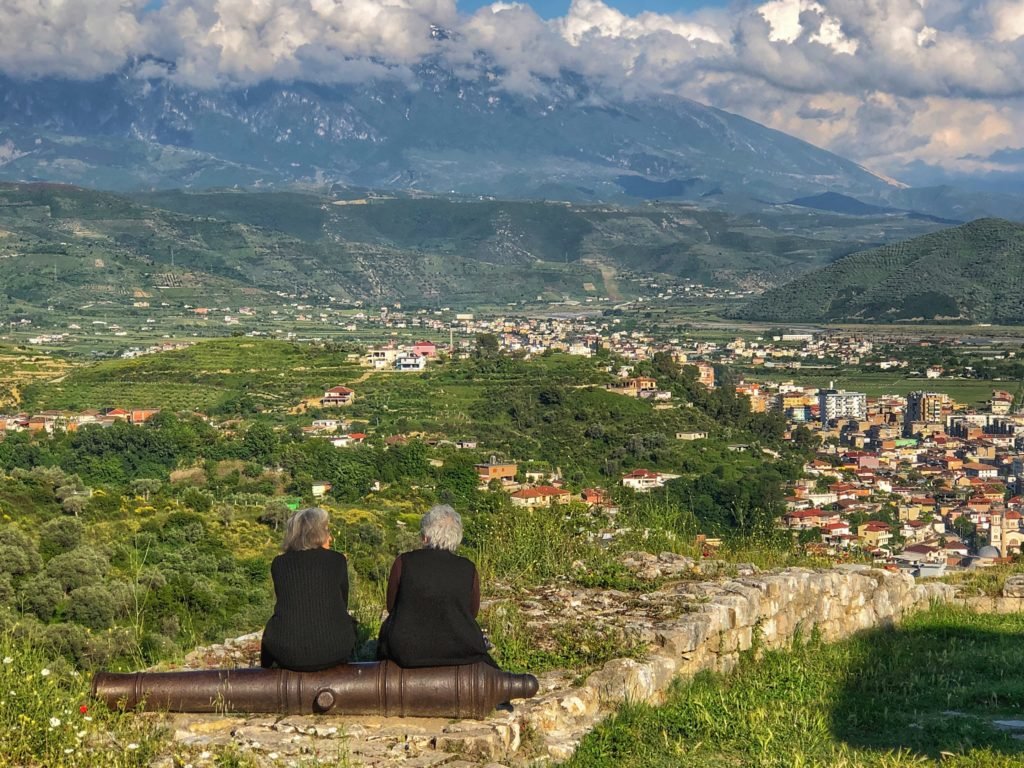
It was time to set our feet in the direction of the 13th Century castle walls, which was a bit of a slog, considering the steep grade. The vast castle walls were built when this region was part of Epirus, which followed the Byzantine Empire. The castle (free?) was built on Illyrian ruins that date back to 400BC. What’s extraordinary about this castle, however, is once you go through the castle gates you’re surrounded not by lifeless ruins and imagined history but by a living functioning community that continues to inhabit homes that date back to 1200. We observed this adorable pair of local ladies who sat (on a cannon) enjoying what appeared to be a habitual evening chat… with a helluva view.
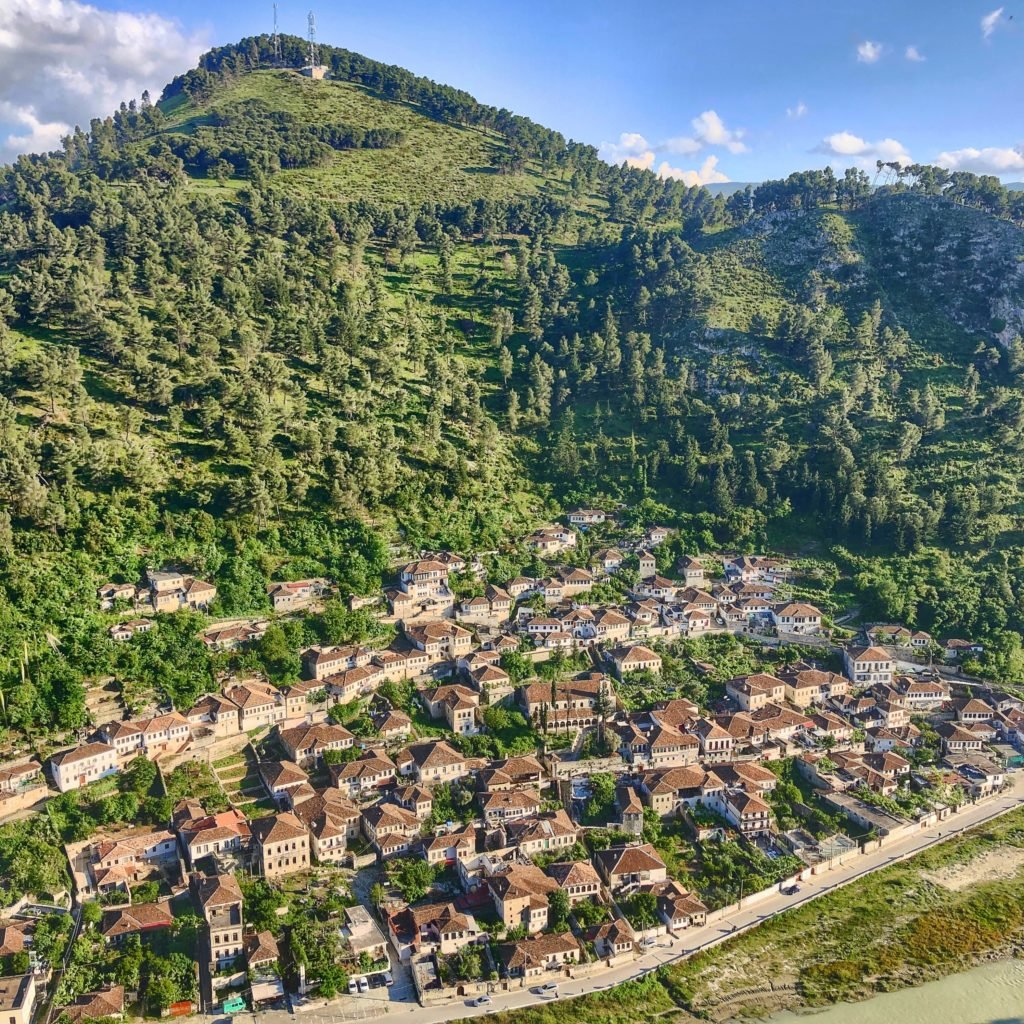
As the town drops away, the views got more and more stunning.
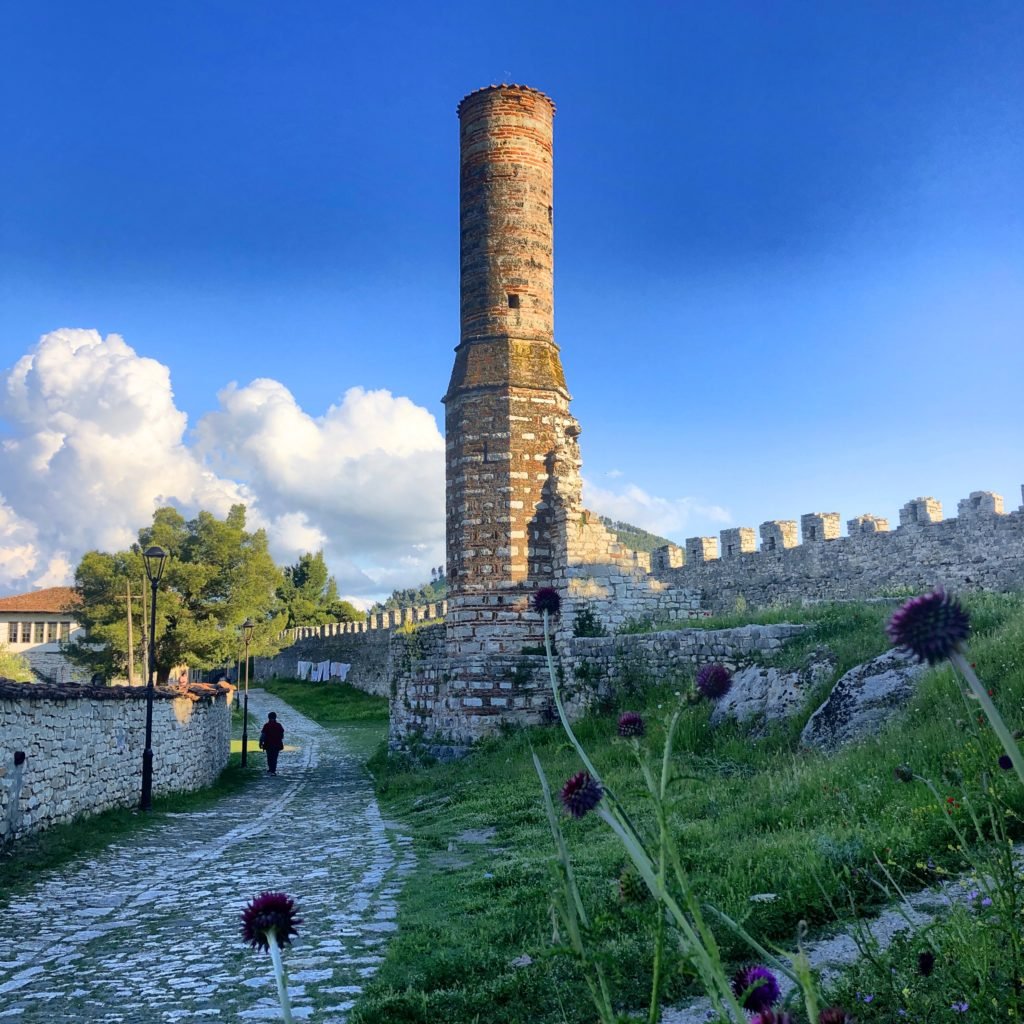
The Red Mosque was built when the Ottomans conquered Berat in 1417. The minaret is all that exists today. We later read you can climb up it. Shoot.
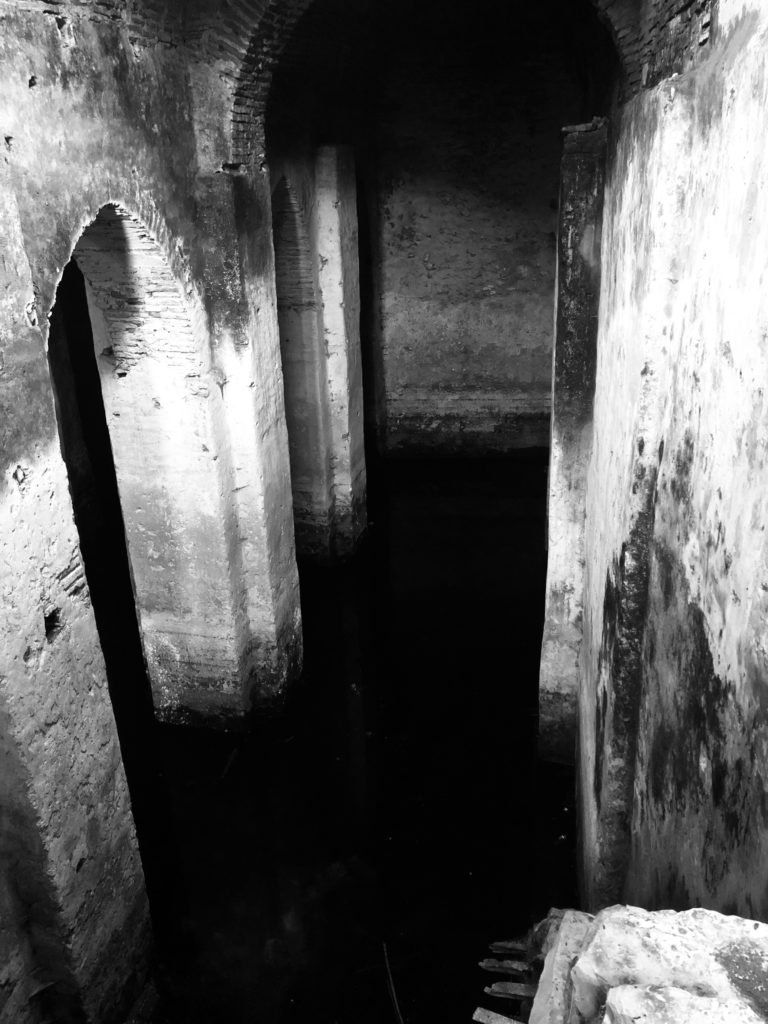
Inside the castle’s 14th Century Byzantine cistern. It still holds lots of water…and lots of bats! Enter if you dare!
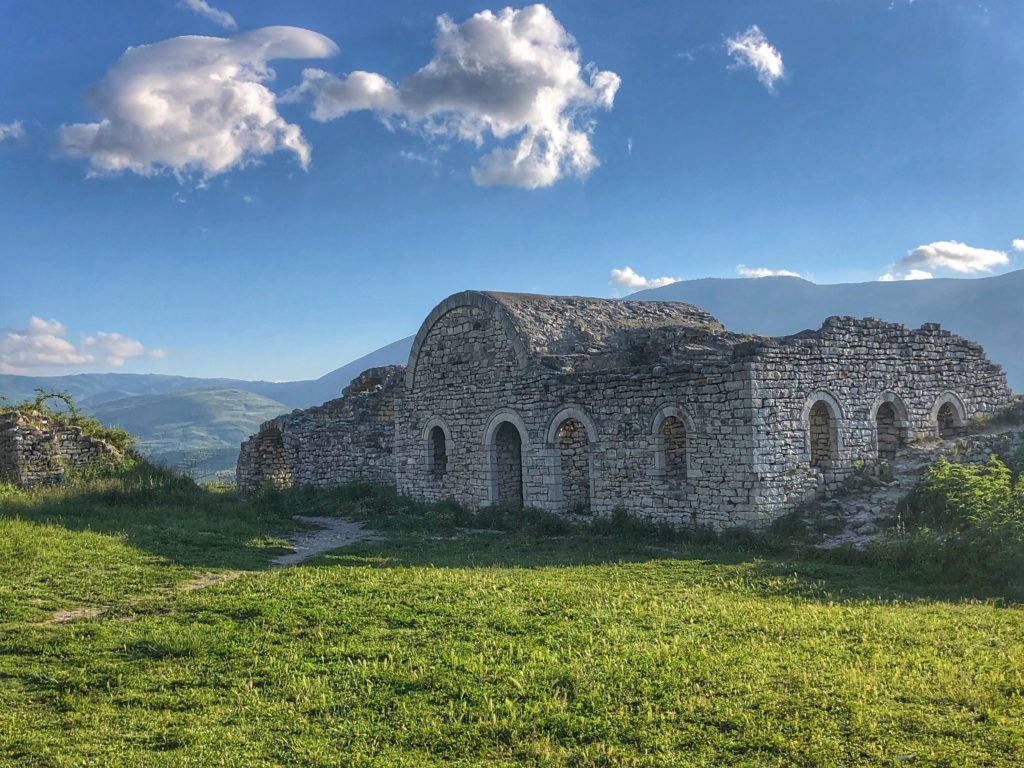
More exquisite remnants inside the castle walls. Its purpose remains a mystery at this point.
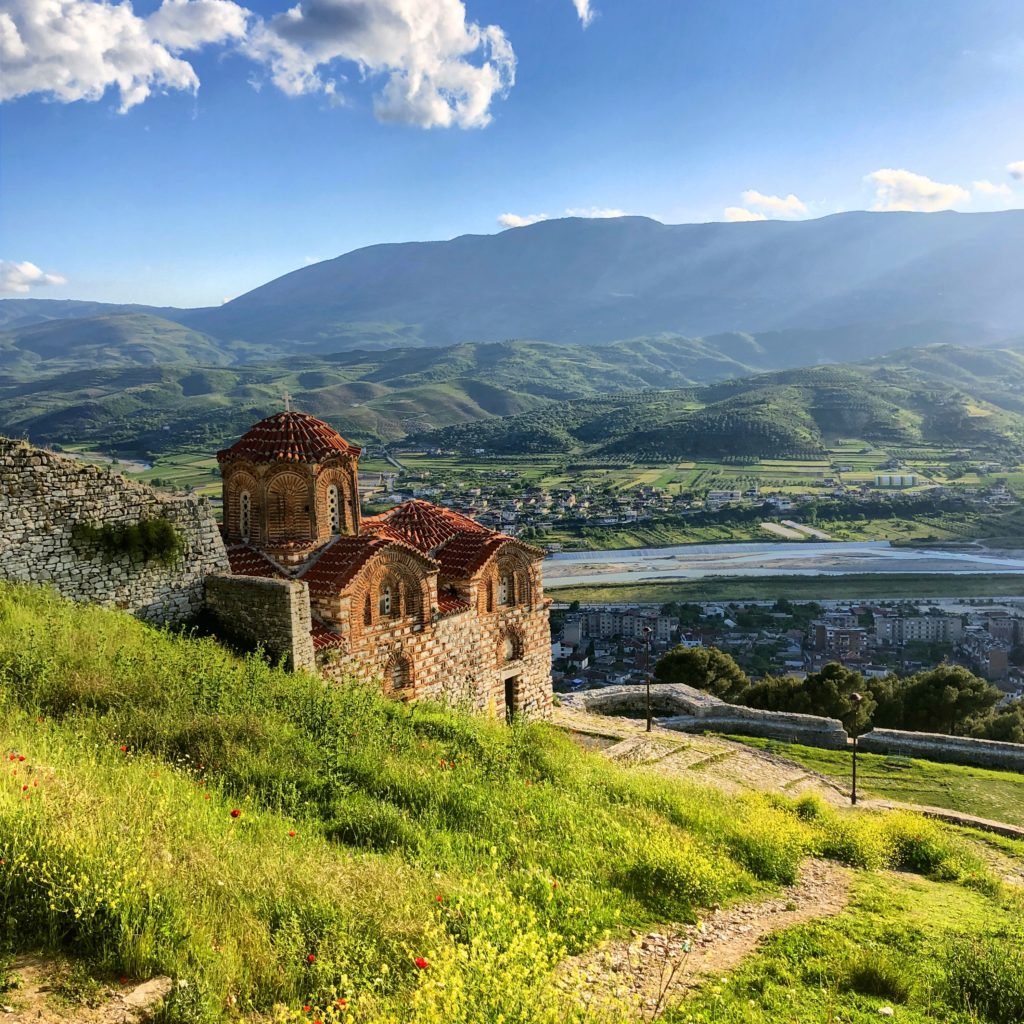
The extraordinarily beautiful Holy Trinity Church is an Orthodox church built in the 14th century and has burnished red Byzantine tiles. It affectionately reminds us of churches and views we saw in Georgia.
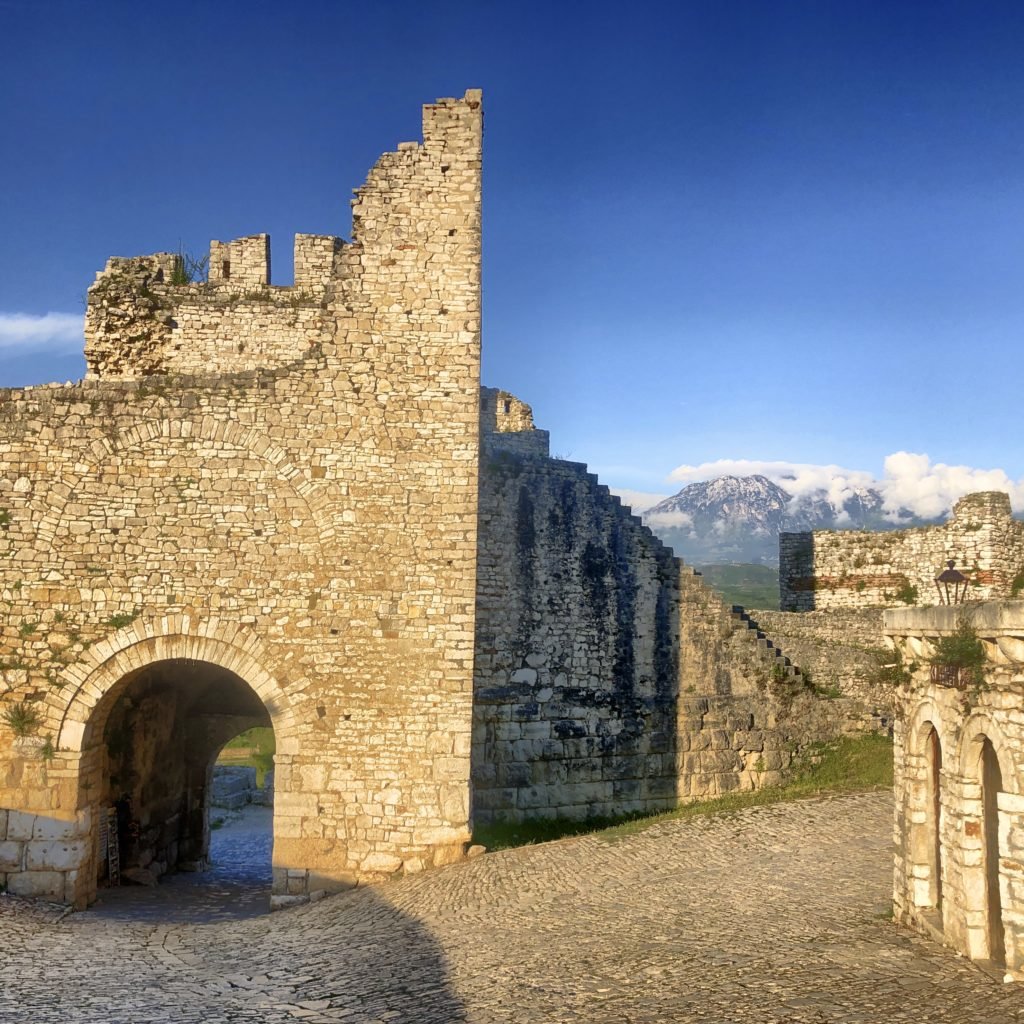
A captivating view of the castle wall and the mountains that surround the area.

You could get lost for hours inside the maze of cobbled alleys amongst Berat’s windowed jewels.
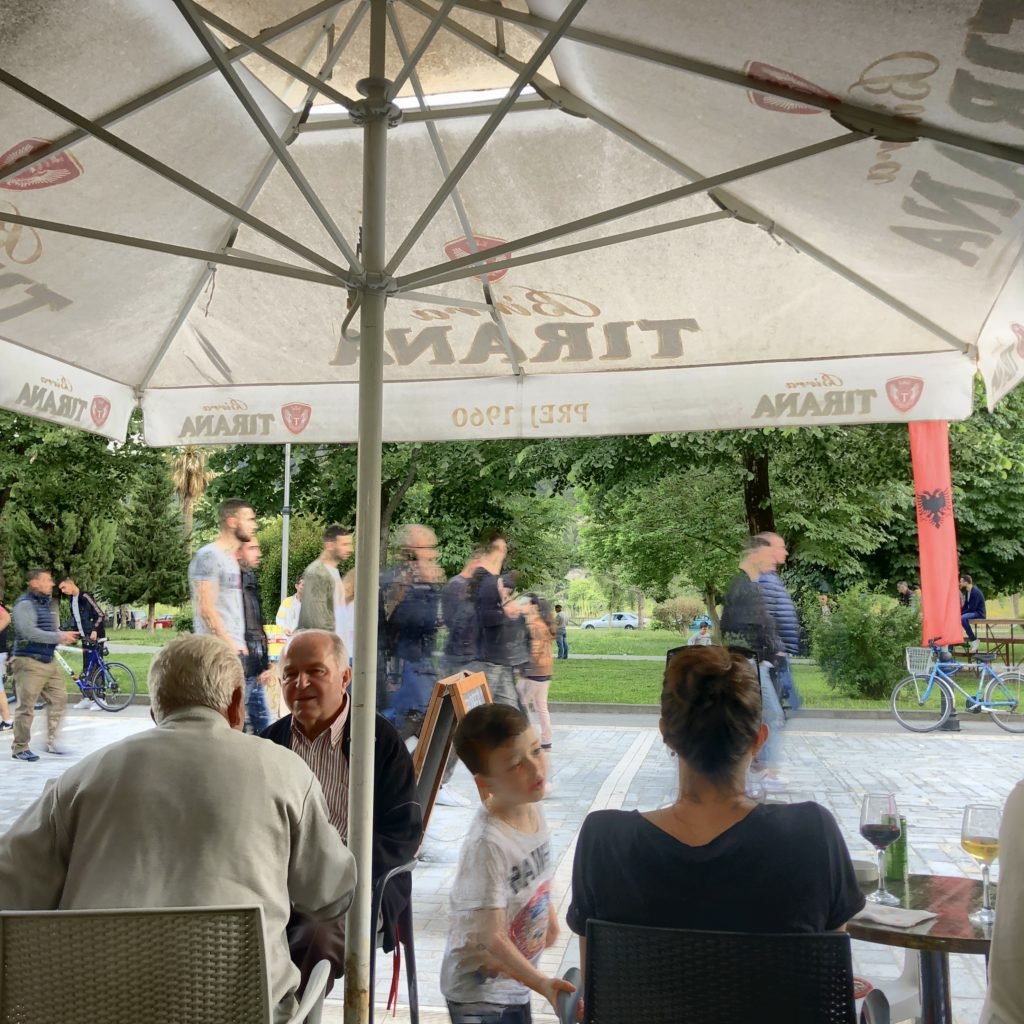
An especially unique aspect of Albanian life that we came to adore is the evening “xhiro.” It’s truly one of the most beautifully simple displays of community that we’ve ever witnessed. It’s like what happens when, for a couple of hours every day, your community collectively chooses to shun modern day distractions and go back to simpler times. It was amazing to see this kind of pure deeply traditional community activity alive and well – among all ages – happening all across Albanina. Essentially the “xhiro” is a dusk time walk which lasts until nightfall where seemingly every resident – young and old – comes outside to stretch their legs and catch up with their neighbours, their friends, colleagues or classmates, and for tweens and teenagers, bat eyes at potential love interests. Usually the walk is on a circuit, and round, and round, and round everyone goes. For those with love interests… this circular repetition is key 😉 Sort of like the ‘cruising’ that we did as teens in the States except, but without driving, or cars, and stuffing your face with Taco Bell and McDonald’s, and having to compete for attention with your wheels, stereos and lipstick.

The early light casts a departing glow on this incredible town. (Side note: one night is NOT enough time in Berat.)

Although Tirana is due north of Berat, the buses go all the way to the city of Durres on the coast, before heading inland to the capital so the journey takes longer than you’d expect, about 2 hours. Once arriving in Tirana, and settling into our new flat were thrilled to find we got an amazing bang for our buck (a running theme in Albania) for our $20/night. We snagged a huge fully renovated one-bedroom apartment that instantly gave us a feeling of a home away from home. And the location was only a couple blocks from the city main square!

Coming into Tirana does leave you struggling a bit with what to make of your first impressions. It isn’t one of those cities that you feel the need to gush about at first glance. Nor, is it someplace you can’t wait to flee. It’s a city that seems to nudge at you, that you have to work a bit at unpacking its goodies. With six total days ahead of us… we felt up for the challenge. And, the rewards! Without a doubt one thing this city has is an exuberantly friendly people. That alone wins over the visitor, very very quickly. As a tourist passing through, you might only see places like this one…the National History Museum housed in a very communist-looking building. You’ll notice the communist style propagandized painting above it that goes by the name “Albania”; and from left to right is supposed to represent the history of the country from antiquity to 1944 (the beginning of the Hoxha regime). If you are intrigued to learn of the turbulent and significant history of the Albanian peoples, this is an excellent first stop you should make.

Twentieth century Albanina history is dark and complex. And troubling. As illustrated, the architecture in Tirana reflects this recent history. You won’t find any historically atmospheric quarters in Tirana. It was never the historic capitol of Albanina, and it was only a mid-sized town until the mid twentieth century. Much of what was there was bulldozed in favor of more “efficient” use of the space. Fortunately however, Tirana elected a mayor in the early 2000’s who was also an artist. And thanks to his leadership, and promotion of the arts once elected he turned the encouraged injecting art into the city’s landscape, and the bleak city began to morph into something a lot brighter today.
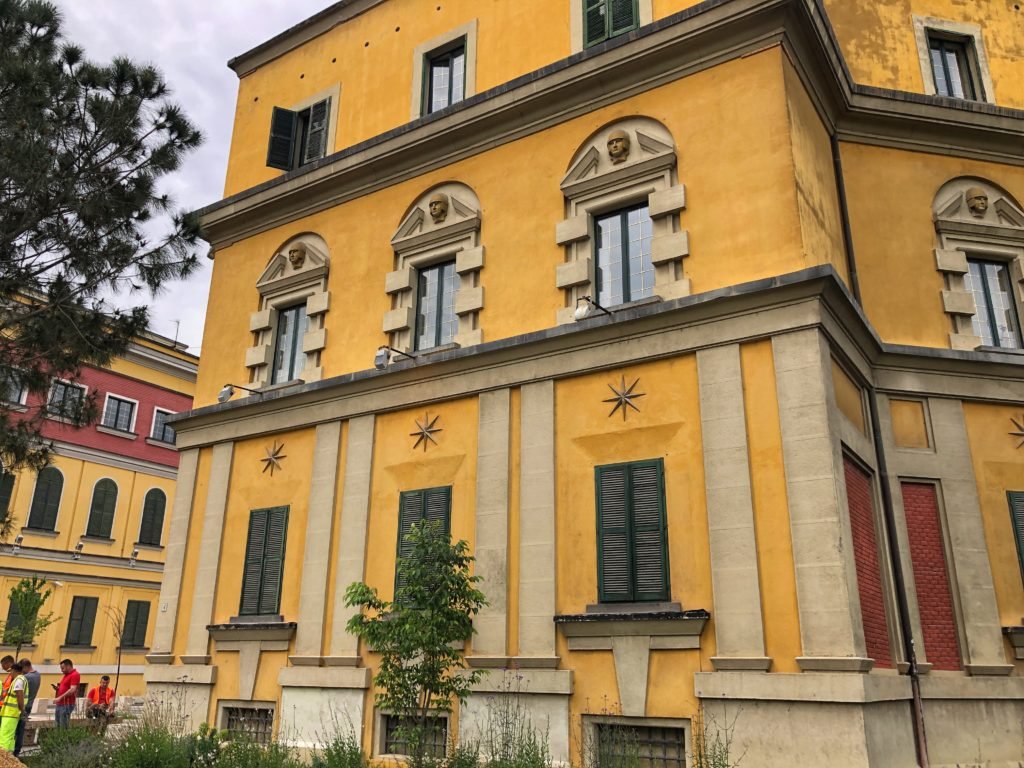
This yellow administrative building near Skanderbeg Square is an example of the mayor’s “more color!” initiative. Skanderbeg is also an Albanian national hero; a military genius and commander for the Ottomans who later defected and returned to Albanina to lead a rebellion against the Ottoman Empire in the mid-1400’s for an independent Albanina state.
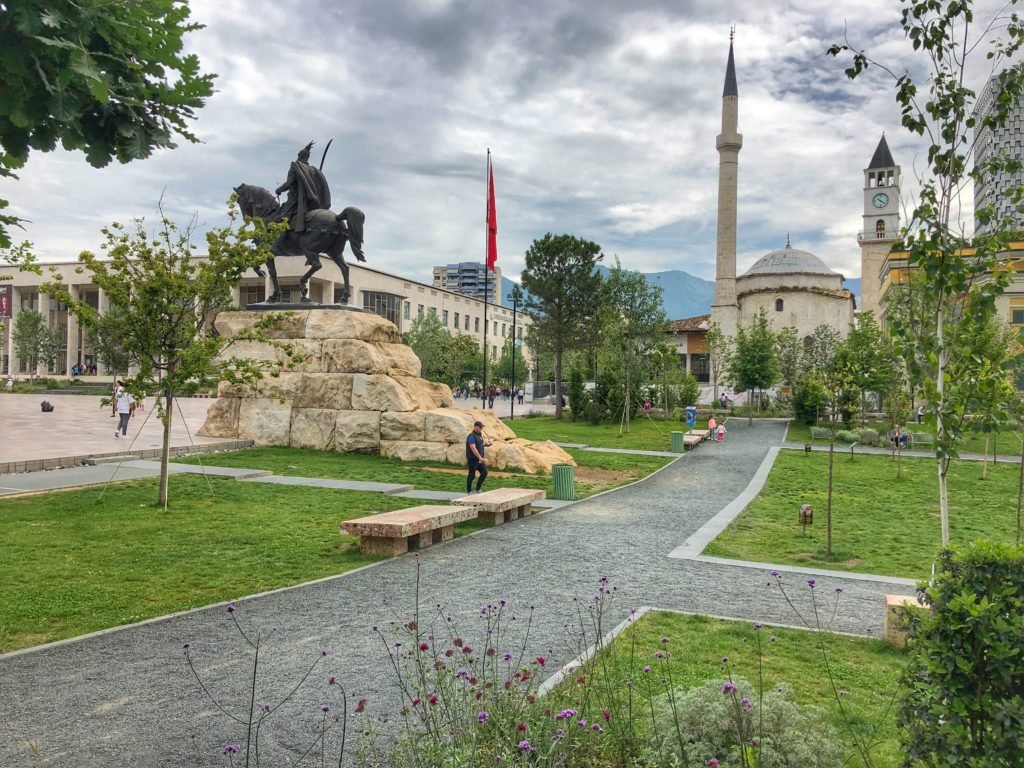
On the edge of Skanderbeg Square sits this view of the esteemed Et`hem Bey Mosque in the back right. This magnificent 18th-century mosque is the oldest in Albania – and has had its own turbulent history. As we’ve mentioned in previous posts, during the communist regime religion was deemed illegal and many thousands of places of worship were destroyed under Hoxha. This mosque, however, despite its prominent location, was miraculously allowed to remain because (thank goodness!) it was chosen to be of especially high historic and cultural significance. So, they preserved it as a museum and cultural attraction.
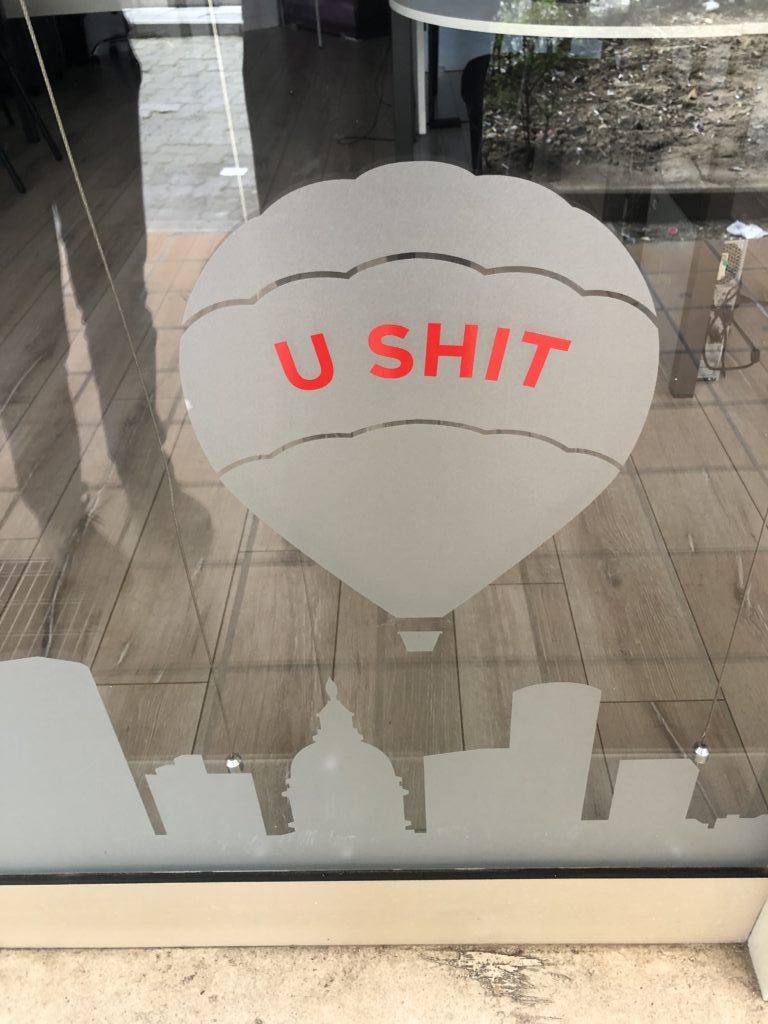
For a little comic relief from all that sadness… this means “it’s sold!” in Albanian.

Embracing western society…
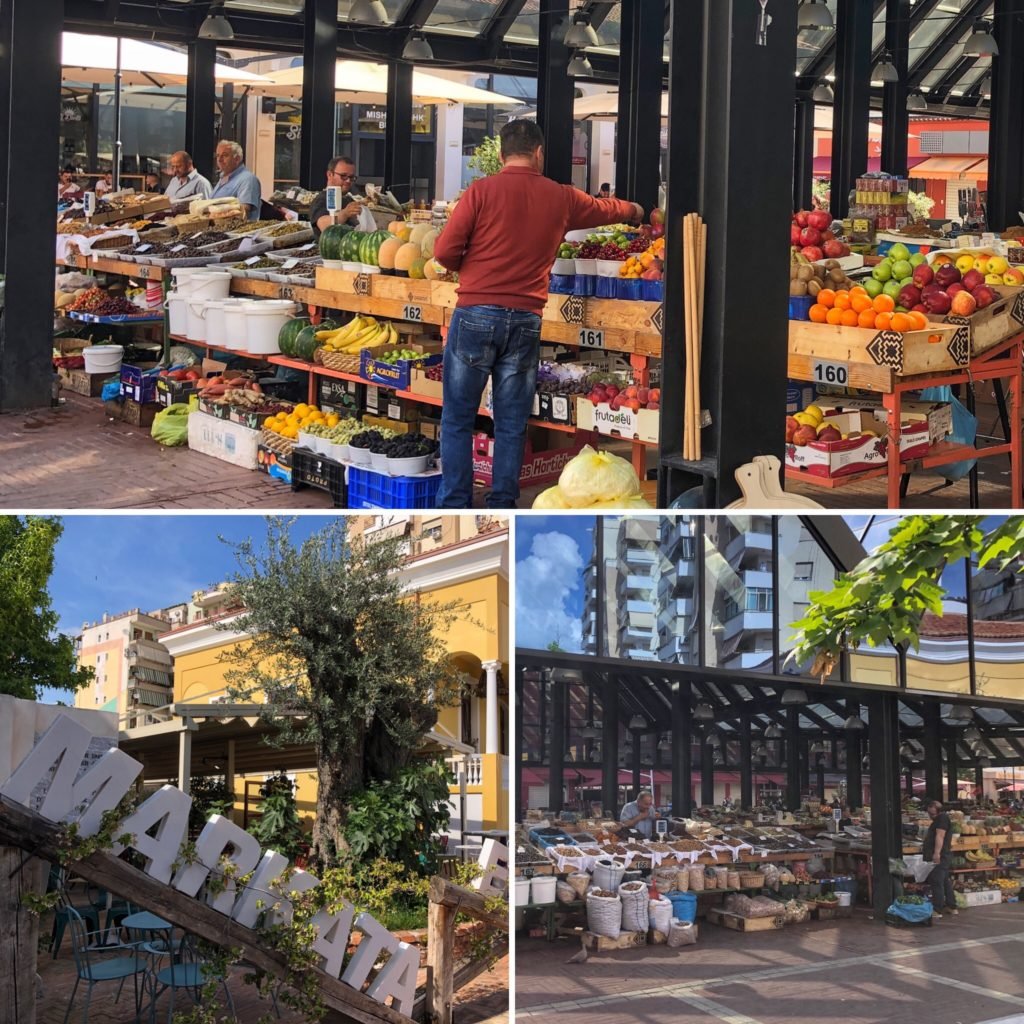
In case that was not…ahem…fulfilling enough, we stumbled upon this exciting central market loaded with local fresh produce and goods. You can really sense the vibrant energy of the city in here. We went almost daily during our time in Tirana!
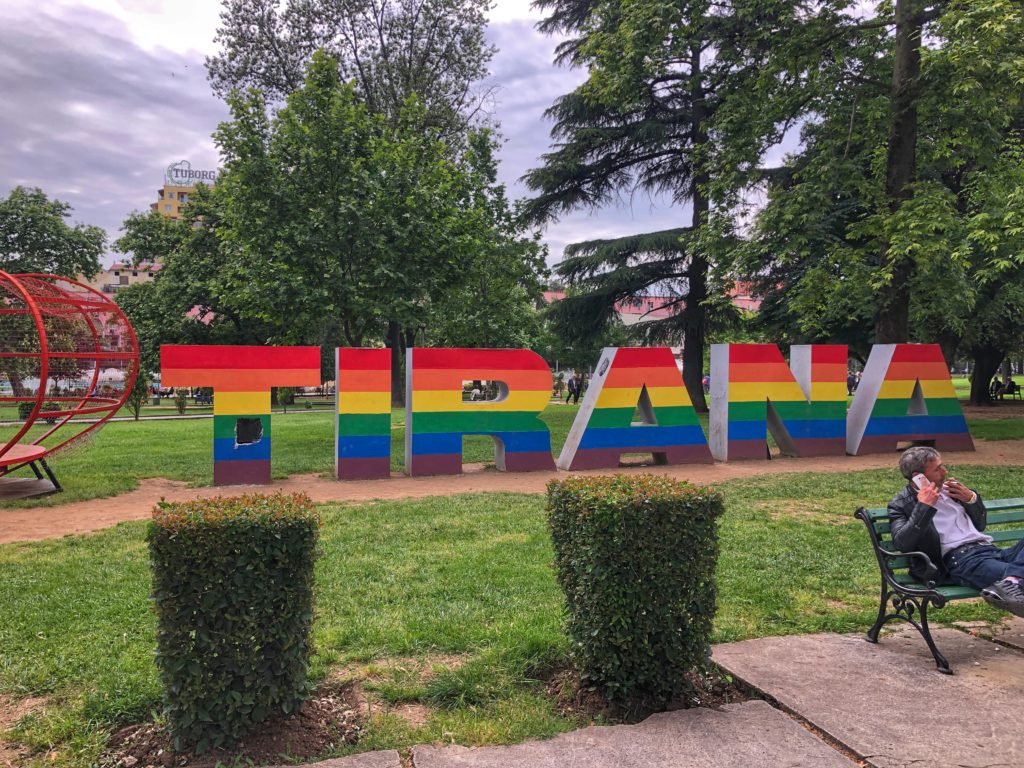
We were thrilled to see the city of Tirana embracing ‘pride’ on its “I love Tirana” sign. Disconcertingly, the next day the rainbow was stripped and it was just a pale pink canvas. After Googling this ‘editing’ we found that the vibrant arts scene in Tirana extends to this sign which is re-splashed every so often with an updated look. We love it!!

Ok, now back to the dark side…a collection of communist era statues rightfully tucked away in a row behind the center for art. We wouldn’t have found this without the help of our ‘free walking tour’ guide. If ever in Tirana we highly recommend taking a tour… you will be surprised at the amount of attractions hiding in plain sight in this elusive city. From left to right a communists who’s who: Lenin, communist propaganda statue, and Hoxha with a busted off nose (wonder why?) These statues were covered for 20 years. Hoxha’s was only revealed one year ago for fear of vandalism and provoking anger. Other brief history tidbits from our guide:
- In 1948, Hoxha was a big proponent of Stalinism.
- In 1963, he accused Russia and Eastern Europe of “not being real communist countries.” This is when the Albanian commies oddly chummed up with Mao, of communist China.
- In 1978, Hoxha then accused China of also not being a real communist country.
- Albanina then went dark. With no trading partners and isolated it lost complete connection with outside world for the next 15 years.
- Crackdowns on communist deviants went into overdrive. TV antennas had to face the direction of the national news. If it was facing the wrong way, you could go to prison.
- No free movement. No migration. If one person in a family managed to escapes the country, everyone in the family is thereafter punished. Cousins, extended family… all punished. For THREE generations after the defector!
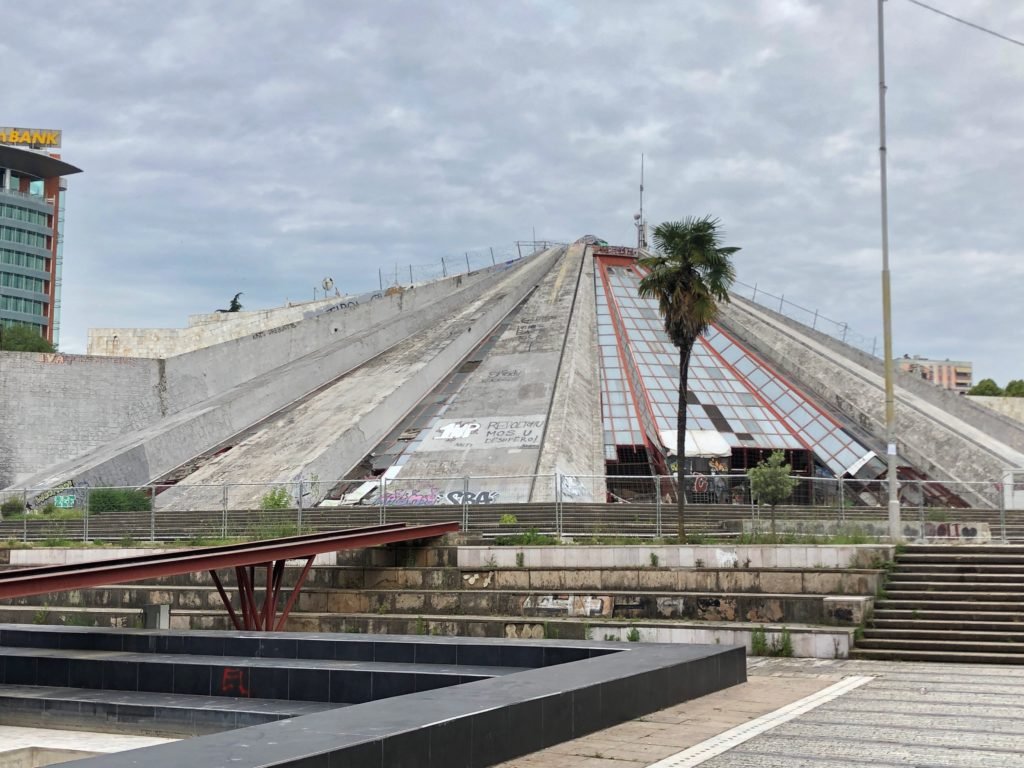
The Pyramid of Tirana. Just like Egypt huh?! This concrete and steel monolith monstrosity was made as a museum and mausoleum to Hoxha after his death in 1985. When built it was said to be the most expensive structure in Albania. When communism ended in 1992, it went through a series of reinventions…from a conference center to a NATO base, to a derelict pile in which people could openly spray paint walk on and skateboard all over. In 2018, the city released plans to repurpose the pathetic remnant of communism to a teen center.
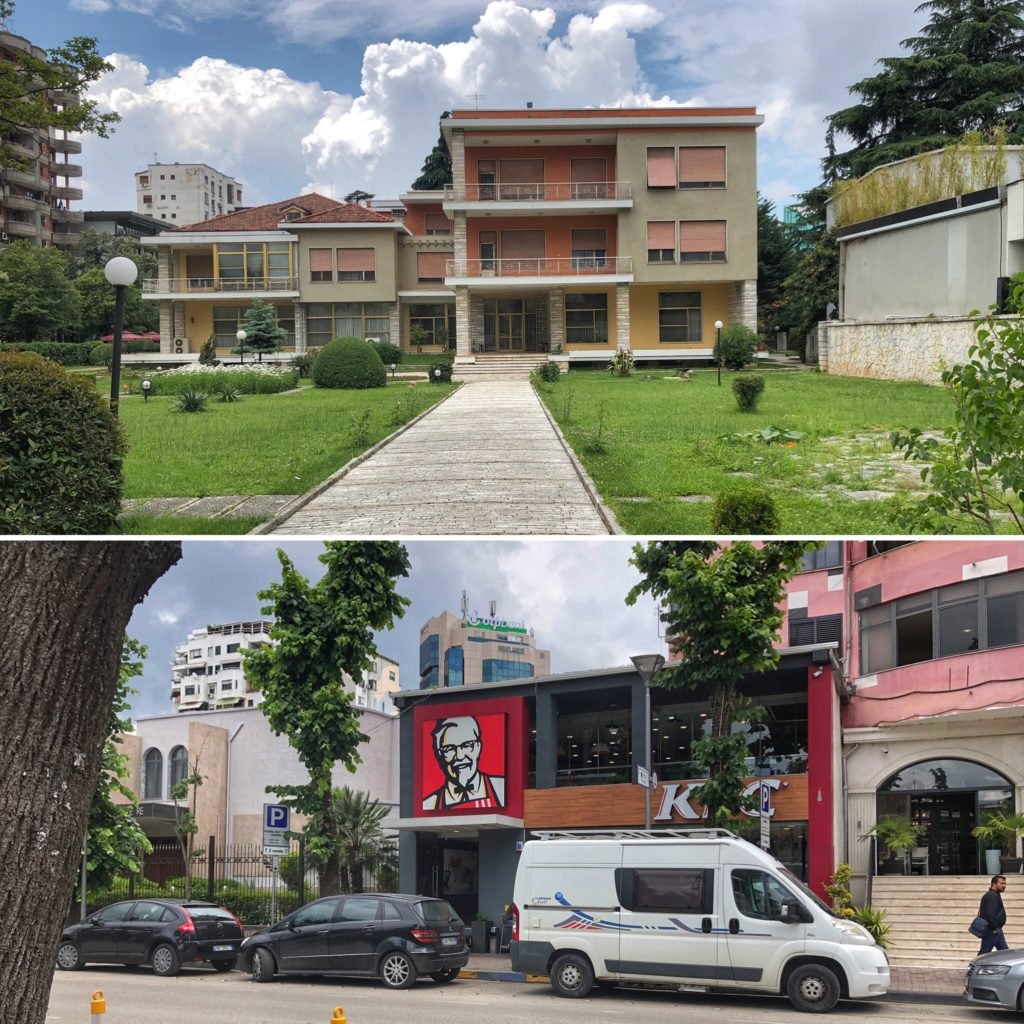
This was Hoxha’s house while in power. Fittingly, one of the first symbols of global capitalism opened its doors across the street from his house. Although KFC has obviously busted in, Tirana is still one of the few European capitals without a McDonald’s or Starbucks.
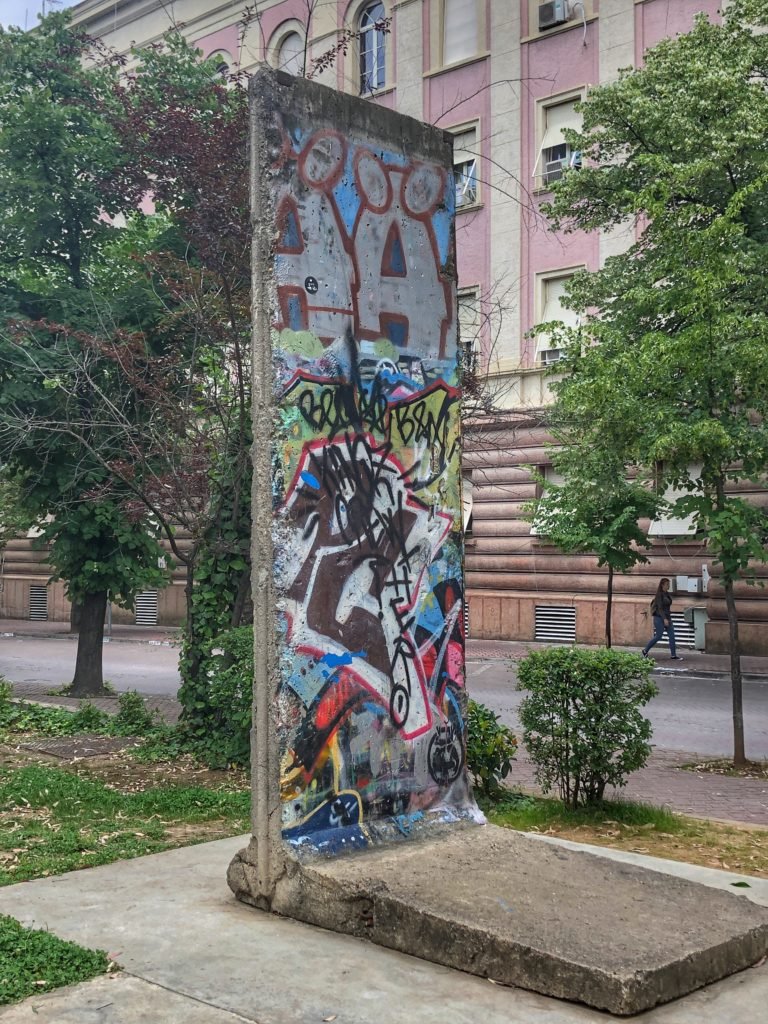
A piece of the Berlin Wall was donated to Tirana several years ago as a reminder of what oppression can do to a society.
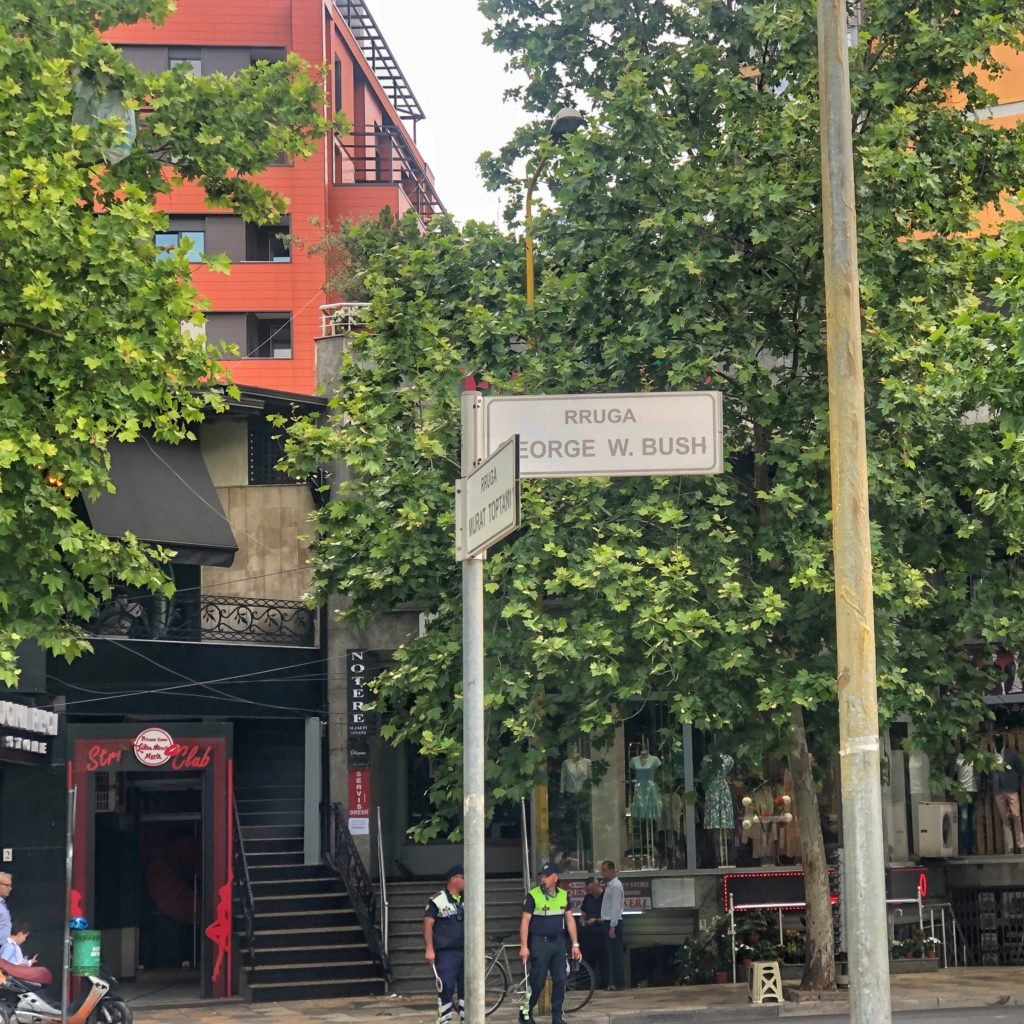
For another comic interlude, Tirana even has a George W Bush street! He received this street by the pro-American Tiranian public because he was the first and only US president to set foot in Albania. Don’t tell Trump he can get a street named after him in Tirana just for showing up…ha. Bush Jr. used the visit to reiterate his support for the UN to recognize Kosovo’s independence.
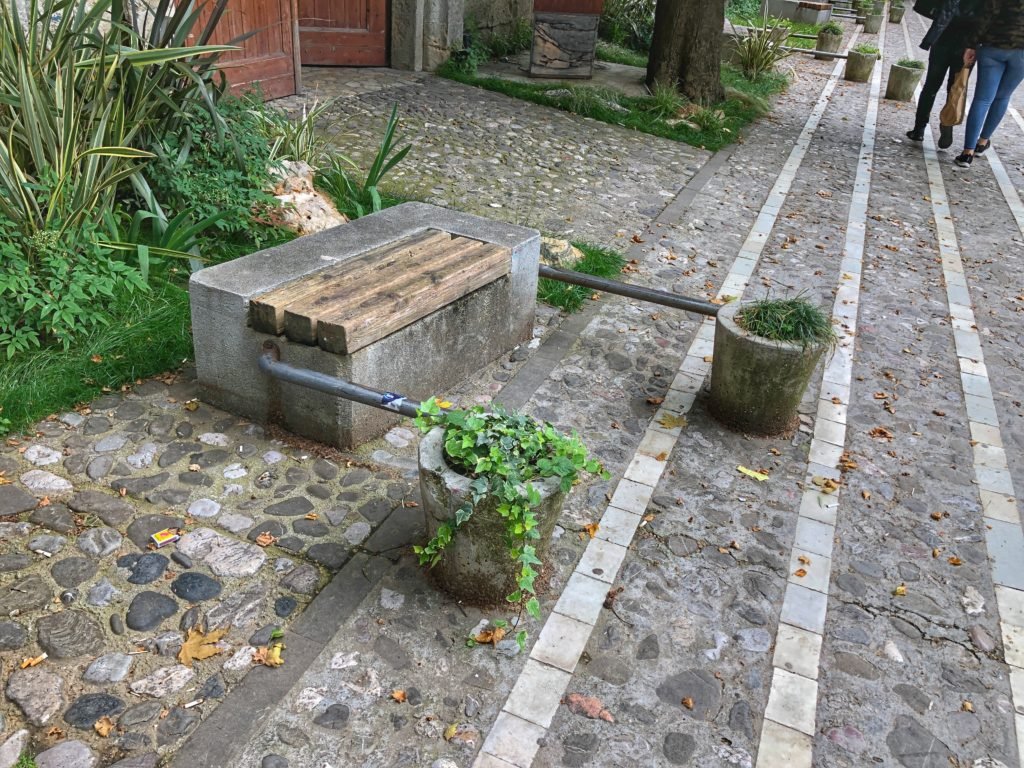
Another of the brilliant artsy mayor’s endeavors…a collection of benches with a musical composure.
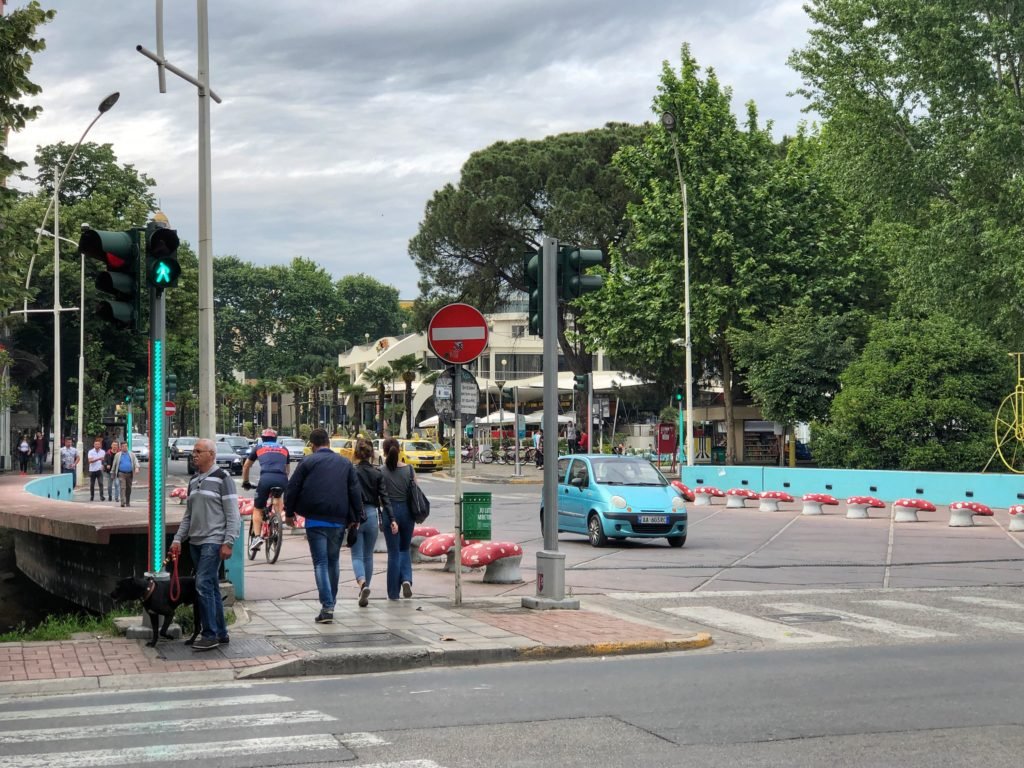
And cute little toadstools to keep people from parking on the sidewalks. Also, check out the cool innovative crosswalk signs!
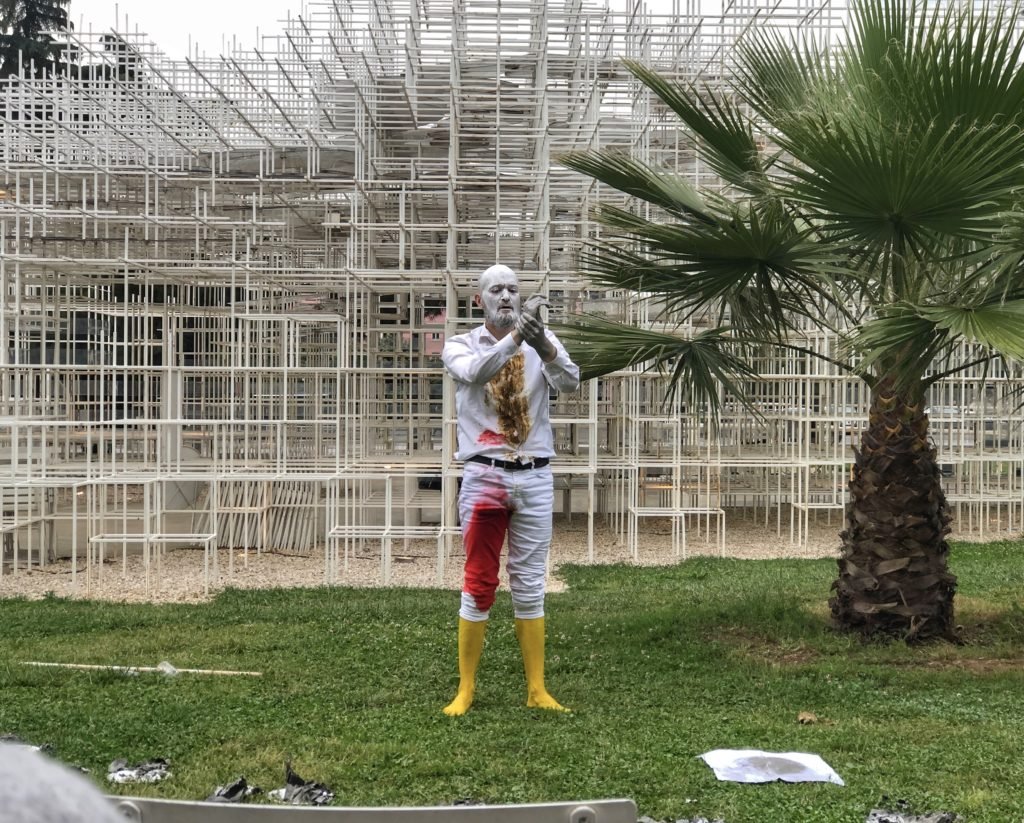
We got to participate in some of the artsy activities while here including the Cloud Festival, in front of the “Cloud Pavilion”, which is a giant piece of modern art shaped like…a cloud. Pictured is one of the free performances we happened upon, which definitely was left open to interpretation, but we loved it! ‘Tis art!
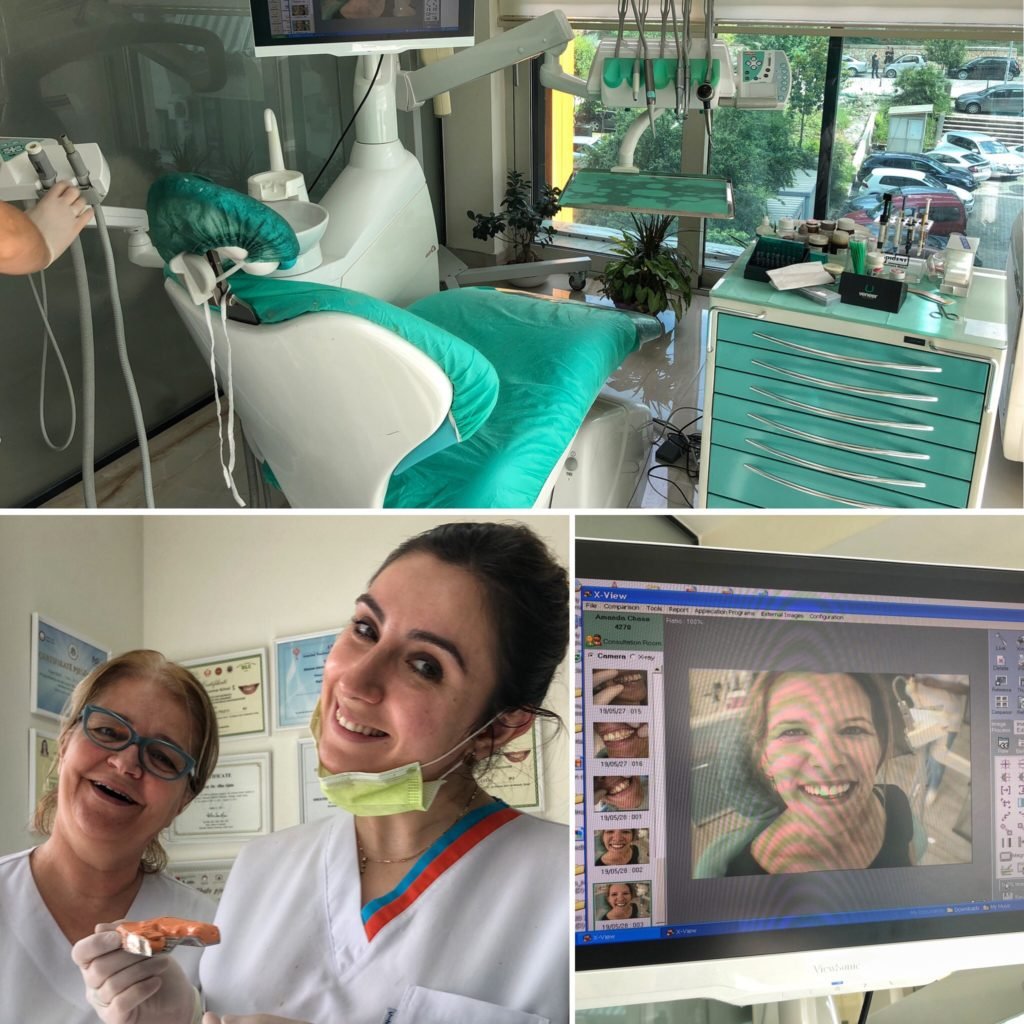
And Mandy also slipped in some time for dental tourism, which was another reason we stayed in Tirana longer than planned. Sure, climbing in a dentist’s chair anywhere can be intimidating. But climbing in a dentist’s chair in a foreign country, even…gasp(!)… Albania could be even more intimidating. It started with a great experience of a cleaning($14.50) and filling ($28) in Sarande with Dr. Eni Shehu and led to a complete set of new sparkling veneers with Dr. Alba at Kiss Dent in Tirana. She used all state-of-the-art materials from the US and Japan and has 50 excellent reviews on google (soon 51). The cost? A rock bottom $1680 for 10 teeth or ($168/tooth). Mandy was quoted $960/tooth for this procedure in Portland. Yeah, we highly doubt we will ever get major dental work in the States again. ?

The massive main square in Tirana, the 40,000 square meter Skanderbeg Square illuminates at night. Yet another great initiative promoted by the art mayor. A few cool things about this square…
- It’s got a parking garage underneath. Yay Tirana for hiding those carbon makers and crafting some utilitarian art!
- Each stone tile of the square is originates from a different region of Albanina.
- The square is “mounded” sloping gently from an apex in the middle. Our first thought was this was for drainage, but what we learned was that this gigantic square is actually a public fountain. Over, 100 jets built within the square which collect water and in the hot summer days, the water erupts! It unfortunately must not have been quite hot enough in the season yet for us!
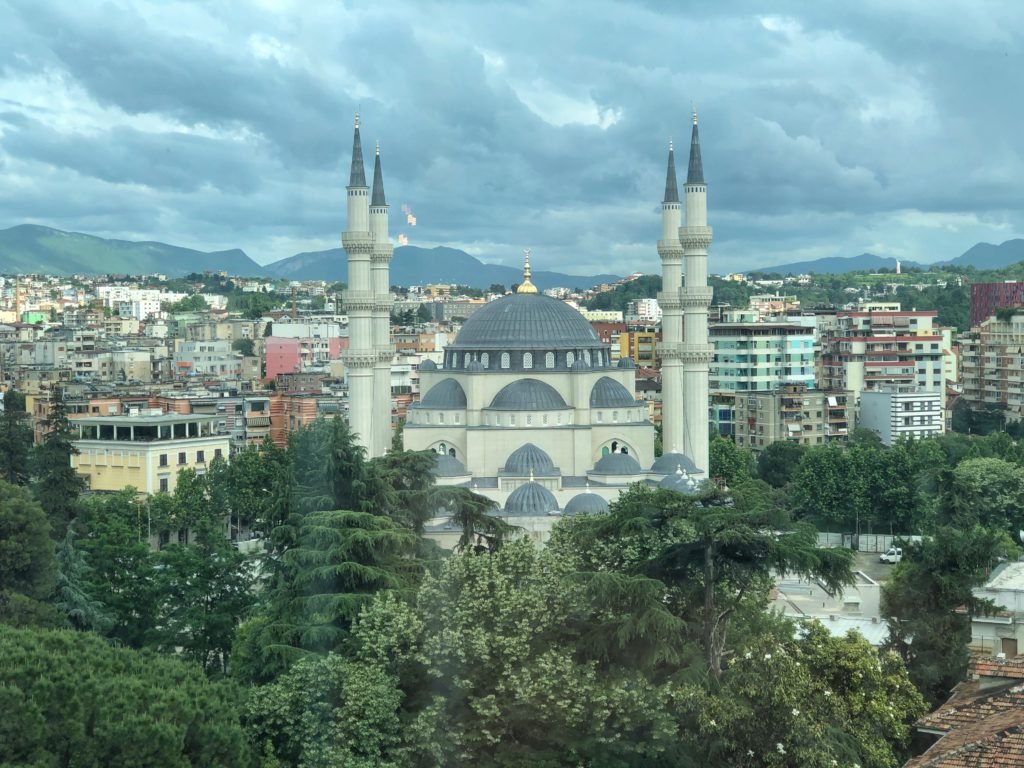
Since 2013, the Great Mosque of Tirana is being constructed with the help of the Turks and when finished, will be the largest mosque in the Balkans.
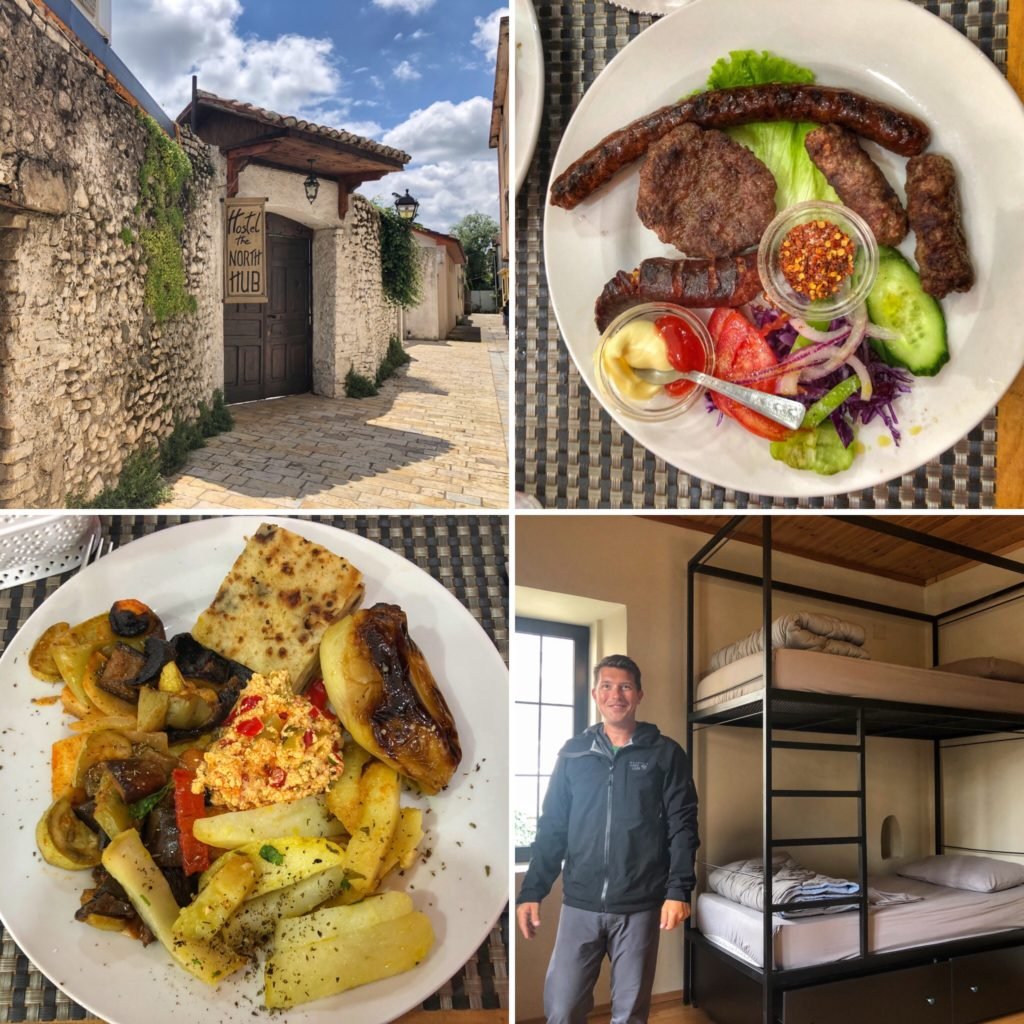
Next we hopped a bus to Shkodër, to transition toward the Montenegrin border. North Hub Hostel ($8.25/bed, including breakfast) was our first hostel in awhile and it was a very comfy and welcome treat. We not only somehow had the entire room to ourselves, but nearly the entire hostel, minus one other guest. We were also able to splurge on one last delicious traditional Albanian meal. Greg of course couldn’t pass up the meatatarian option, while Mandy countered with the vegetarian. Whichever your preference, all will be very happy here! All this… was about $6.80.

Another great thing about travel is meeting up with friends you’ve met along the way. Mandy grabs a beer with Natalia from the blog, “Something of Freedom” who we met in Sibiu, Romania.
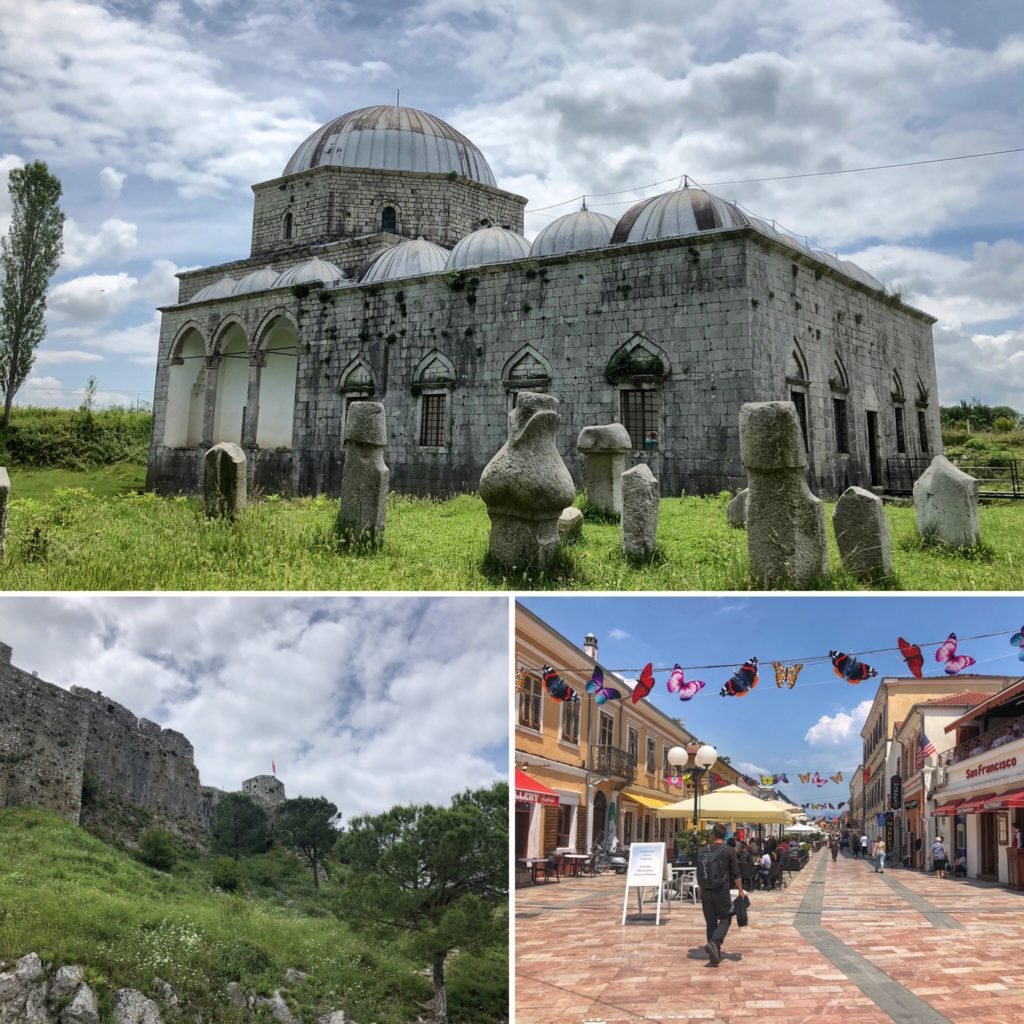
Shots of Shkodër…
- The architecturally unique Lead Mosque, finished in 1778 was voted one of the most beautiful Islam monuments in the world. And, you guessed it…all the cupolas are made of lead. Don’t breathe too deep.
- The castle of Shkodër
- The main pedestrian street
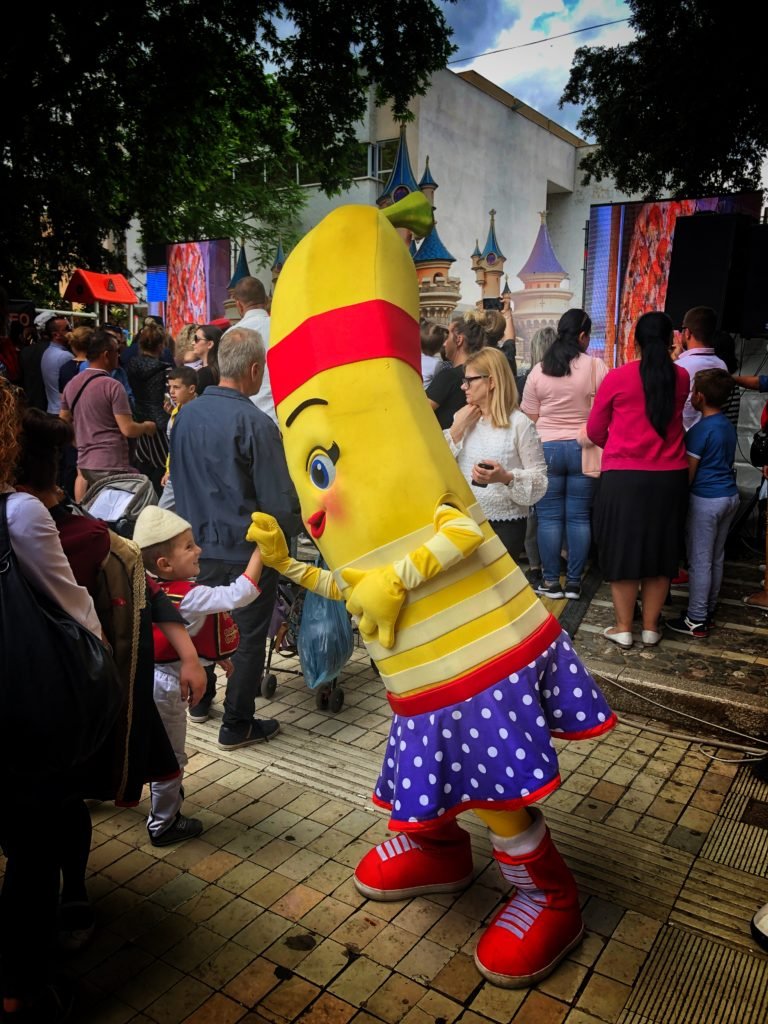
Not unlike a Norman Rockwell painting, there is so much to unpack in this snapshot capturing a banana high-fiving this little Alabanian boy. It really struck us, especially after learning about Albania’s recent history as we did. Why bananas in Albanina are momentous? Because before 1992, in Hoxha’s time, most citizens had never seen a banana in their lives. Imagine 50 years of oppression ending and in a matter of weeks, being exposed to imported foods, toys, clothes, cars, technology, and other peculiarities from the outside world. Albania has come an inconceivably long way in a short amount of time. Although they still encounter festering and insidious low level corruption on a daily basis, a potential future bid for the EU boosts their resilient and hopeful spirits. With resources like these their future is beyond bright.
Albania Travel Budget (28 Days)
- Accommodation $641 ($23/night average) all private rooms
- Restaurants: $152
- Groceries: $141
- Transport: $187
- Sightseeing: $15
- Miscellaneous: $86
- Grand Total: $1222 (~$43.64/day)

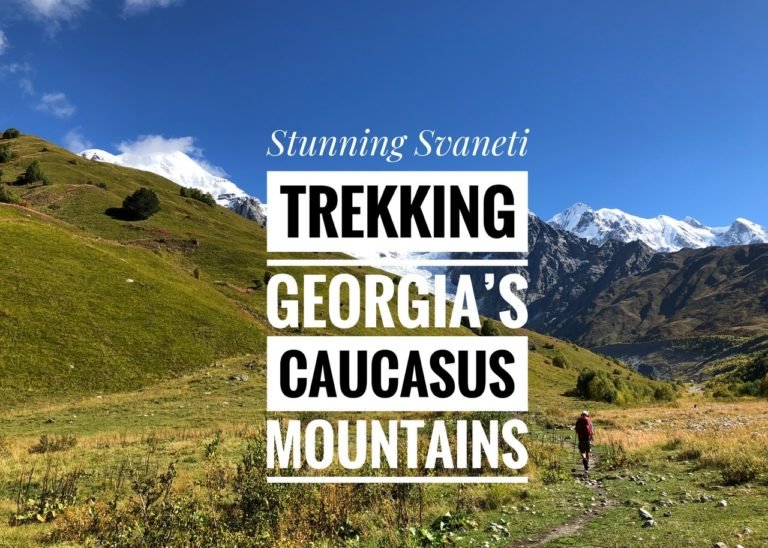
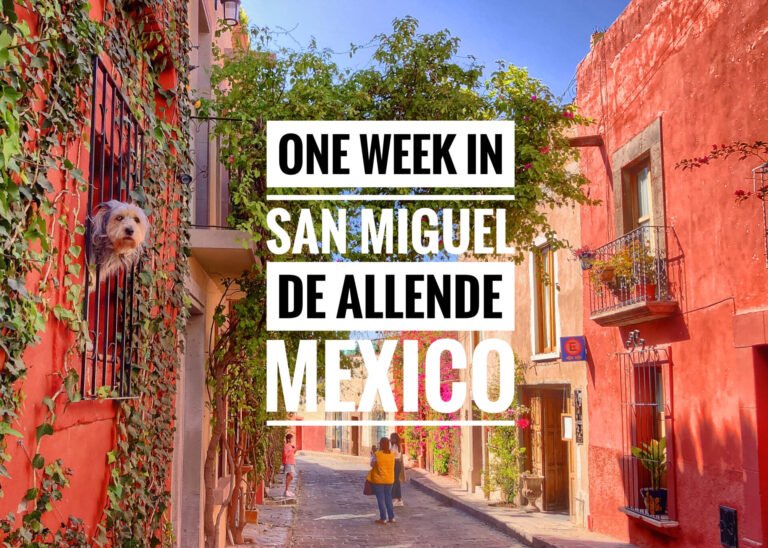
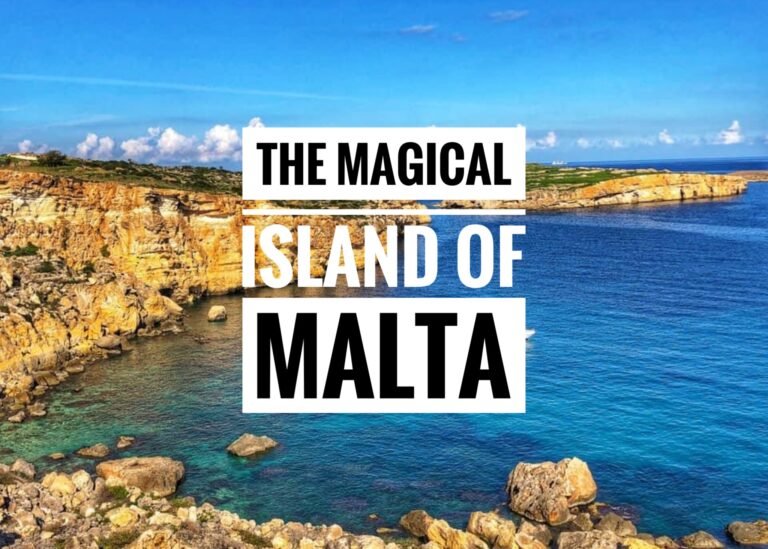
and that’s USD I presume for two of you. Amazing. You did all local buses and no car hire which would’ve ramped it up. I’m so excited for my trip.
I’m excited for you!! Albania is definitely an amazing country with a unique personality. Yes, all our costs are in USD for both of us. We very very rarely hire cars and have relied on public transportation for years!